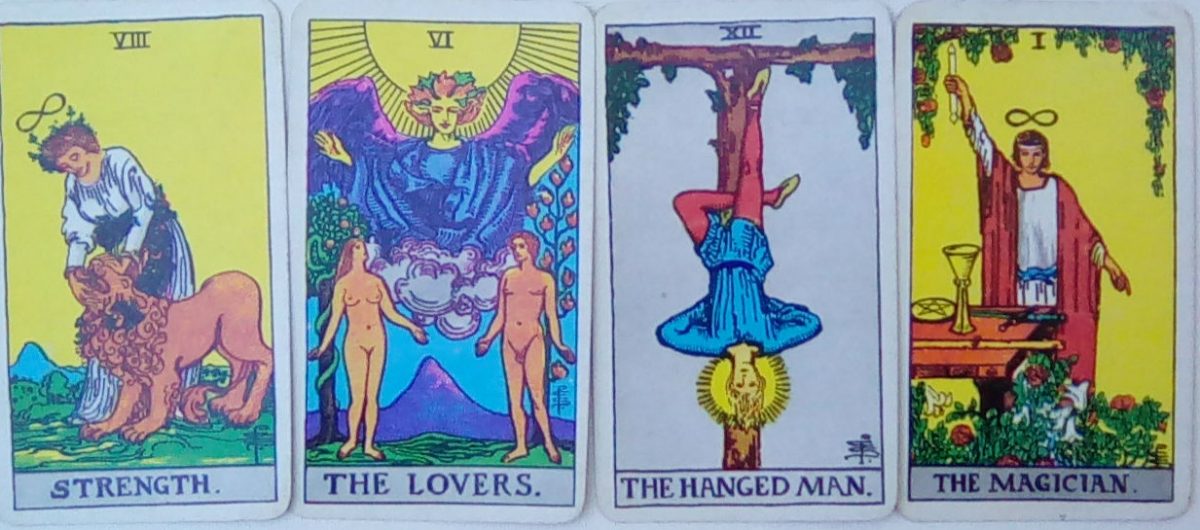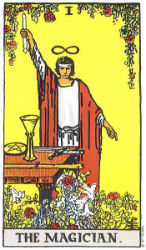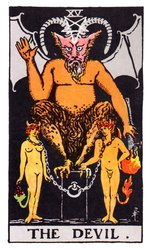
The Tarot card The Hierophant shows us a Pope-like figure seated on a throne, with acolytes bowing down to him. In a general sense, The Hierophant represents all that is traditional, conformist, and conventional. In a more specific sense, he represents dogmatic religion, as opposed to spirituality.
The basic idea here is that if you want to learn about religion and what it teaches, you go to a priest, a pastor, a rabbi, or an imam. If you want to learn about spirituality, you meditate or you take psychedelics or get involved with a tradition such as shamanism or ecstatic dance. Religion involves learning about other people’s interactions with the divine. Spirituality is about having your own interaction with the divine.
I started thinking about all of this the other day when I read this passage from David Michies sweet little book, “Buddhism for Busy People:”
“One of the refreshing things about Buddhism, however, is its insistence that you should only take up those practices which benefit you. If certain aspects aren’t helpful, simply put them to one side. You can always come back to them later. You won’t go to hell because you don’t believe in karma. Nor will believing in it guarantee you a place in heaven – like everything else in Buddhism, it is what you DO that counts, not what you say you believe.”
I was contrasting that in my own mind to a Catholic priest I saw on a news show recently inveighing on the subject of Catholics who supported a woman’s right to have an abortion. “We don’t agree with, ‘super-market Catholicism,’ “ he said. “You’re not allowed to push your cart down the aisle and pick out this part of the Catholic faith but reject other parts. You have to accept the entire doctrine or you’re not really a practicing Catholic.”
The differences in the two approaches couldn’t be any clearer. Buddhism is basically saying, “Hey, here’s what we think the truth is but you need to pick out what works for you.” Traditional religions are saying, “Here’s what the truth is and you need to agree with it, even if it seems like nonsense to you.” The Buddha actually encouraged his followers to debate him on concepts they disagreed with and cast aside whatever they thought was wrong. On the other hand, it’s Catholic doctrine that whatever the Pope says about faith is infallibly true. Always. From god’s mouth to his ear. Period.
The difference in those approaches probably lies in ancient human history when our cultures had shamans rather than priests and pastors. Our ancestors undoubtedly found the world to be a scary place that was full of mysterious and sometimes life threatening occurrences. We can easily imagine a cave woman leaning against a tree enjoying a rainstorm when -KABLAM!!!!!!!! – a bolt of lightning blows the tree into splinters and flings her twenty feet through the air.
Her first response would probably be something along the lines of, “Holy shit, what was THAT?!?”
As she clambered to her feet, though, and brushed the mud and splinters from her loin cloth she’d have a brilliant insight: something must have CAUSED the lightning thingie that blew up the tree. And since the lightning thingie came out of the sky, whatever caused it must live . . . up there . . . in the sky.
She’d probably spend many nights around the cave fire discussing this with the other tribe members, comparing notes, and arguing about the exact nature of the . . . Sky Thingie . . . that threw the . . . lightning thingie . . . at the tree. What was it like? Was it like a human being? Why would it do such a thing? Did it hate trees? Perhaps it had been aiming the lightning at the woman and missed her and hit the tree? Did it have poor eyesight, then? What was it so pissed off about, anyway? Was it a male or a female thingie? And if it was a male thingie, did it have . . . you know . . . a thingie?
So there would have been many complex disputations arising out of the tree being hit by the lightning. At a certain point, a cave person would step out of the shadows and say, “Hey, I had a dream about the Sky Thingie that threw the lightning thingie. He says that if you’ll sacrifice a goat and not eat shellfish he won’t do it again.”
“Oh, really?” someone might reply. “So the Sky Thingie is definitely a male?”
“Well, yes. And he has a beard and wears sandals and sits on a golden rock.”
“So, you can talk to him, then? Did he say why he’s throwing lightning thingies at us?”
“He did it because you didn’t sacrifice a goat and you ate clams. Those are the rules. He told me.”
Thus was born the shaman: a special class of human beings who had knowledge of and were able to intervene with supernatural forces. He or she would no doubt have been seen as just as important – or more so – than the tribal hunters, fishers, or gatherers. After all, she had a special relationship with the Sky Thingie and could protect the tribe from supernatural temper fits and, um, sky anomalies.
The tribe would have soon realized two things: (a) like all humans the shaman was mortal and would die at some point; (b) therefore, he needed to train other shamans to take his place and keep a record of the Sky Thingie’s rules.
Thus were born priests and religions.
As the centuries passed and the priest/shamans had more and more visions and wrote down more and more rules from the Sky Thingies, the rules got more and more complex and began to include things like:
- Don’t eat bacon.
- Don’t trip blind people.
- Don’t have sex with sheep.
- Don’t work on Saturday.
- It’s okay to have slaves, but only for seven years.
- The Sky Thingie loves you and if you don’t believe that we’ll kill you.
- Always capitalize the Sky Thingie’s name. If you don’t, we’ll kill you.
- Never draw a picture of the Sky Thingie or we’ll kill you.
- Women are property and they should cover their heads and faces. Or we’ll kill you.
You can tell from the last few rules that things started to take a nasty turn somewhere along the way and that the priests and religions were getting more powerful in society. Not only had they established themselves as the only people who could interpret what the Sky Thingie wanted, they could also kill anyone who even tried to talk to the Sky Thingie on their own.
That’s really the point that we’re at with many of today’s formal religions. They consist of centuries of barnacle-like accretions of irrational rules that can only be interpreted by the priests and pastors and rabbis. Intelligent self inquiry is NOT encouraged.
Which is why the Buddhist approach is so refreshing.
Formal religions have rules like, “Don’t eat bacon because the Sky Thingie says not to.” Buddhist discussions are more like:
“Don’t eat bacon.”
“Why not? I really like BLT’s.”
“Do you want to be happy and avoid pain?”
“Well, yes.”
“Do you think pigs want to be happy and avoid pain?”
“Um . . . well . . . yes. I suppose they do.”
“Do you think it’s painful to be raised in a tiny pen and killed when you’re young?”
“Well . . . yes.”
“Would you be happy if someone cut you up, fried you in a teflon pan and slapped you on a piece of bread with some tomatoes and lettuce?”
“Well, no.”
“Then don’t eat bacon.”
And, of course, even then, you’re free to eat bacon sandwiches if you want to. No one will kill you and you won’t go to hell. You might reincarnate as a pig, but, hey, fair’s fair, right?
As long as we’re on the subject of food, think of it this way: religion is like being invited to a huge Thanksgiving dinner. There are platters full of turkey and mashed potatoes and baked yams and apple pies and cornbread dressing and green bean casseroles with those strange fried onion things on top.
Maybe you really hate baked yams or green beans and you just want a little turkey and dressing with mashed potatoes and gravy. But, no, there’s a huge scary guy with a baseball bat at the head of the table and he says that you have to eat EVERYTHING!!! Especially the green beans and yams. Or he’ll kill you. And then you’ll go to hell. Gulp.
Spirituality, on the other hand, is more like a buffet line. You walk along, looking at the varieties of food and you only pick out the food that appeals to YOU. You don’t force down every single thing on the line just to prove that you’re faithful. If you feel like a shrimp salad instead of Swedish meatballs, that’s what you get.
“Meditation? Yes, I think I’ll take a bit of that. Hmmm . . . Wicca . . . does that fit on my plate right now? Maybe as a side dish? Oh, look . . . it’s affirmations and positive thinking. Man, I haven’t had those in FOREVER. Yum. . .”
There are no priests or pastors standing at your shoulder telling you that you REALLY want the roast beef instead of the tacos. YOU choose what’s nourishing for you at that moment and take a pass on what doesn’t feed your soul. And it’s an all you can eat buffet. You’re always free to go back for second helpings.
But maybe skip the bacon sandwich. Just consider it.




